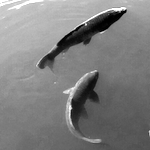Competitive divers are able to attain much higher scores when they perform a splash-less entry. To achieve this goal, they use the ``rip'' entry maneuver where they roll their body forward in a somersault immediately after impact. This dynamic shape change from a slender to a bluff body after impact separates them from previously studied entry bodies. A geometrically simplified diver model is designed to perform a passive roll after impact. An experimental setup is developed to drive this model into a pool of water and capture the approach, impact, and underwater trajectory with a high speed camera. Modifications to this model are made to control the rate of deformation after impact. The model's trajectory after impact is tracked to identify the time it takes for each model to complete its deformation after impact. The size of the entrained air cavity is estimated using threshold functions. A non-dimensional time based on the time to complete deformation is found to collapse the estimated size of the air cavity for all models that deform before pinch off. Fixed models are introduced to compare the hinged models to non-deforming entry bodies. The hinged models are found to have between 42%-154% larger estimated air cavities during the final measurement than their fixed counterpart. At the moment of deep seal, two distinct air cavities are formed: one that connects to the atmosphere above the pool that has smooth walls and a lower cavity largely composed of small bubbles. The effect of this change in air cavity formation on final splash is investigated by tracking the movement of the upper air cavity connected to the atmosphere after deep seal. The results will begin to explain how Olympic divers are able to use the rip entry to reduce their splash.

 PDF version
PDF version
